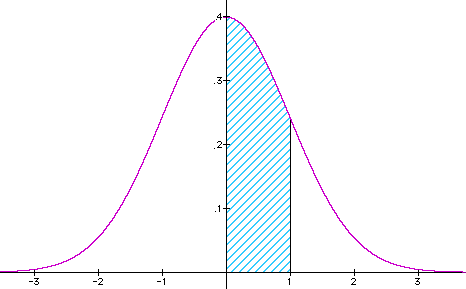![]()
The normal distribution
The normal distribution curve is given by the function:
![]()
The mean = 0, and the standard deviation = 1.
The total area under the curve = 1. So the value A(1) = .3413 in Table 11.3 (on page 204 of the notes) means that about 34% of the area under the normal curve is between the lines x = 0 and x = 1.

So, by symmetry, the area between the lines x = -1 and x = +1 is 2·0.3413 = 0.6826.
Thus, about 68% of the total area under the normal curve is between these two lines.
We say that a random variable is distributed normally if its distribution looks like the normal curve, after shifting to get the correct mean and re-scaling (stretching or shrinking) to get the right standard deviation. So, it follows from the discussion above that if a random variable is distributed normally, then the probability of a value being within 1 standard deviation of the mean is about 0.68.
Example: Suppose that scores on an exam are
normally distributed,
with mean = 80 and standard deviation = 8. Then
the scores which are
within 1 standard deviation of the mean are between
80 - 8 = 72 and 80 + 8 = 88.
Using the Table 11.3 again, the value A(2) = 0.4772 means that about 47.7% of the area under the normal curve is between the lines x = 0 and x = 2.

By symmetry, it follows that about 95.4% of the area under the normal curve is between the lines x = -2 and x = 2. So, if a random variable is normally distributed, then the probability of a value being less than 2 standard deviations away from the mean is 0.954.
In our example (with ![]() and
and![]() ) around 95.4%
percent of the scores are between 80 - 2·8 = 64 and 80 +
2·8 = 96.
) around 95.4%
percent of the scores are between 80 - 2·8 = 64 and 80 +
2·8 = 96.